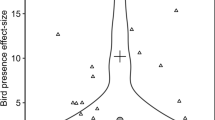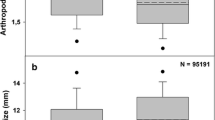Abstract
Top-down effects of predators can have important consequences for ecosystems. Insectivorous birds frequently have strong predation effects on herbivores and other arthropods, as well as indirect effects on herbivores’ host plants. Diet studies have shown that birds in temperate ecosystems consume arthropods in winter as well as in summer, but experimental studies of bird predation effects have not attempted to quantitatively separate winter predation impacts from those in summer. To understand if winter foraging by insectivorous birds has consequences for arthropods or plants, we performed a meta-analysis of published bird exclusion studies in temperate forest and shrubland habitats. We categorized 85 studies from 41 publications by whether birds were excluded year-round or only in summer, and analyzed arthropod and plant response variables. We also performed a manipulative field experiment in which we used a factorial design to exclude birds from Quercus velutina Lam. saplings in winter and summer, and censused arthropods and herbivore damage in the following growing season. In the meta-analysis, birds had stronger negative effects on herbivores in studies that included winter exclusion, and this effect was not due to study duration. However, this greater predation effect did not translate to a greater impact on plant damage or growth. In the field experiment, winter exclusion did not influence herbivore abundance or their impacts on plants. We have shown that winter feeding by temperate insectivorous birds can have important consequences for insect herbivore populations, but the strength of these effects may vary considerably among ecosystems. A full understanding of the ecological roles of insectivorous birds will require explicit consideration of their foraging in the non-growing season, and we make recommendations for how future studies can address this.




Similar content being viewed by others
References
Askenmo C, von Brömssen A, Ekman J, Jansson C (1977) Impact of some wintering birds on spider abundance in spruce. Oikos 28:90–94
Barber NA, Marquis RJ (2009) Spatial variation in top-down direct and indirect effects on white oak (Quercus alba L.). Am Midl Nat 162:169–179
Barber NA, Marquis RJ (2011a) Light environment and the impacts of foliage quality on herbivorous insect attack and bird predation. Oecologia 166:401–409
Barber NA, Marquis RJ (2011b) Leaf quality, predators, and stochastic processes in the assembly of a diverse herbivore community. Ecology 92:699–708
Belovsky G, Slade JB (1993) The role of vertebrate and invertebrate predators in a grasshopper community. Oikos 68:193–201
Betts MM (1955) The food of titmice in oak woodland. J Anim Ecol 24:282–323
Bock CE, Bock JH, Grant MC (1992) Effects of bird predation on grasshopper densities in an Arizona grassland. Ecology 3:1706–1717
Branson DH (2005) Direct and indirect effects of avian predation on grasshopper communities in northern mixed-grass prairie. Environ Entomol 34:1114–1121
Duffy JE (2003) Biodiversity loss, trophic skew and ecosystem functioning. Ecol Lett 6:680–687
Elser JJ, Bracken MES, Cleland EE, Gruner DS, Harpole WS, Hillebrand H, Ngai JT, Seabloom EW, Shurin JB, Smith JE (2007) Global analysis of nitrogen and phosphorus limitation of primary production in freshwater, marine, and terrestrial ecosystems. Ecol Lett 10:1135–1142
Forkner RE, Hunter MD (2000) What goes up must come down? Nutrient addition and predation pressure on oak herbivores. Ecology 81:1588–1600
Forkner RE, Marquis RJ, Lill JT (2004) Feeny revisited: condensed tannins as anti-herbivore defences in leaf-chewing herbivore communities of Quercus. Ecol Entomol 29:174–187
Gibb JA (1960) Populations of tits and goldcrests and their food supply in pine plantations. Ibis 102:163–208
Graber JW, Graber RR (1979) Severe winter weather and bird populations in southern Illinois. Wilson Bull 91:88–103
Gunnarsson B (1996) Bird predation and vegetation structure affecting spruce-living arthropods in a temperate forest. J Anim Ecol 65:389–397
Hedges LV, Gurevitch J, Curtis PS (1999) The meta-analysis of response ratios in experimental ecology. Ecology 80:1150–1156
Holmes RT, Sturges FW (1975) Bird community dynamics and energetics in a northern hardwoods ecosystem. J Anim Ecol 44:175–200
Holmes RT, Schultz JC, Nothnagle P (1979) Bird predation on forest insects: an exclosure experiment. Science 206:462–463
Jansson C, Bromssen A (1981) Winter decline of spiders and insects in spruce Picea abies and its relation to predation by birds. Ecography 4:82–93
Joern A (1986) Experimental study of avian predation on coexisting grasshopper populations (Orthoptera: Acrididae) in a sandhills grassland. Oikos 46:243–249
Joern A (1992) Variable impact of avian predation on grasshopper assemblies in sandhills grassland. Oikos 64:458–463
Laurent JL (1986) Winter foraging behaviour and resource availability for a guild of insectivorous gleaning birds in a southern alpine larch forest. Ornis Scand 17:347–355
Le Corff J, Marquis RJ (1999) Difference between understory and canopy in herbivore community composition and leaf quality for two oak species in Missouri. Ecol Entomol 24:46–58
Lichtenberg JS, Lichtenberg DA (2002) Weak trophic interactions among birds, insects and white oak saplings (Quercus alba). Am Midl Nat 148:338–349
Mäntylä E, Klemola T, Laaksonen T (2011) Birds help plants: a meta-analysis of top-down trophic cascades caused by avian predators. Oecologia 165:143–151
Marquis RJ, Le Corff J (1997) Estimating pre-treatment variation in the oak leaf-chewing insect fauna of the Missouri Ozark Forest Ecosystem Project (MOFEP). In: Brookshire BL, Shifley S (eds) Proceedings of the Missouri Ozark Forest Ecosystem Project Symposium: an experimental approach to landscape research (Gen Tech Rep NC-193). USDA Forest Service, Washington, DC, pp 342–346
Marquis RJ, Whelan CJ (1994) Insectivorous birds increase growth of white oak through consumption of leaf-chewing insects. Ecology 75:2007–2014
Miliczky ER, Horton DR, Calkins CO (2008) Observations on phenology and overwintering of spiders associated with apple and pear orchards in south-central Washington. J Arachnol 36:565–573
Mooney KA (2006) The disruption of an ant–aphid mutualism increases the effects of birds on pine herbivores. Ecology 87:1805–1815
Mooney KA (2007) Tritrophic effects of birds and ants on a canopy food web, tree growth, and phytochemistry. Ecology 88:2005–2014
Mooney KA, Gruner DS, Barber NA, Van Bael SA, Philpott SM, Greenberg R (2010) Interactions among predators and the cascading effects of vertebrate insectivores on arthropod communities and plants. Proc Natl Acad Sci USA 107:7335–7340
Murakami M, Nakano S (2000) Species-specific bird functions in a forest-canopy food web. Philos Trans Roy Soc B 267:1597–1601
Oksanen L, Fretwell SD, Arruda J, Niemela P (1981) Exploitation ecosystems in gradients of primary productivity. Am Nat 118:240–261
Paine RT (1980) Food webs: linkage, interaction strength and community infrastructure. J Anim Ecol 49:667–685
Pinheiro J, Bates D, DebRoy S, Sarkar D, R Development Core Team (2012) nlme: linear and nonlinear mixed effects models (in R package version 3.1-103). R Foundation for Statistical Computing, Vienna
R Development Core Team (2010) R: a language and environment for statistical computing. R Foundation for Statistical Computing, Vienna
Schmitz OJ, Hamback PA, Beckerman AP (2000) Trophic cascades in terrestrial systems: a review of the effects of carnivore removals on plants. Am Nat 155:141–153
Shurin JB, Borer ET, Seabloom EW, Anderson K, Blanchette CA, Broitman B, Cooper SD, Halpern BS (2002) A cross-ecosystem comparison of the strength of trophic cascades. Ecol Lett 5:785–791
Sipura M (1999) Tritrophic interactions: willows, herbivorous insects and insectivorous birds. Oecologia 121:537–545
Solomon ME, Glen DM, Kendall DA, Milsom NF (1976) Predation of overwintering larvae of codling moth (Cydia pomonella (L.) by birds. J Appl Ecol 13:341–352
Strong AM, Sherry TW, Holmes RT (2000) Bird predation on herbivorous insects: indirect effects on sugar maple saplings. Oecologia 125:370–379
Van Bael SA, Philpott SM, Greenberg R, Bichier P, Barber NA, Mooney KA, Gruner DS (2008) Birds as predators in tropical agroforestry systems. Ecology 89:928–934
Venables WN, Ripley BD (2002) Modern applied statistics with S, 4th edn. Springer, New York
Williams JB, Batzli GO (1979) Winter diet of a bark-foraging guild of birds. Wilson Bull 91:126–131
Zuur AF, Ieno EN, Walker NJ, Saveliev AA, Smith GM (2009) Mixed effects models and extensions in ecology with R. Springer, Berlin
Acknowledgments
We thank A. Loayza, E. Justus, and the staff at Tyson Research Center for invaluable help. K. Mooney and three anonymous reviewers provided helpful comments that greatly improved the manuscript. This work was supported by University of Missouri-TWA scholarships, the St. Louis Audubon Society, USEPA-STAR Fellowship #FP91648501, and Northern Illinois University.
Author information
Authors and Affiliations
Corresponding author
Additional information
Communicated by Sven Bacher.
Electronic supplementary material
Below is the link to the electronic supplementary material.
Rights and permissions
About this article
Cite this article
Barber, N.A., Wouk, J. Winter predation by insectivorous birds and consequences for arthropods and plants in summer. Oecologia 170, 999–1007 (2012). https://doi.org/10.1007/s00442-012-2367-z
Received:
Accepted:
Published:
Issue Date:
DOI: https://doi.org/10.1007/s00442-012-2367-z




